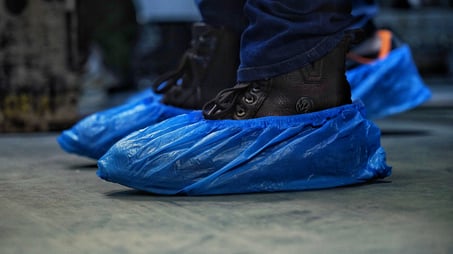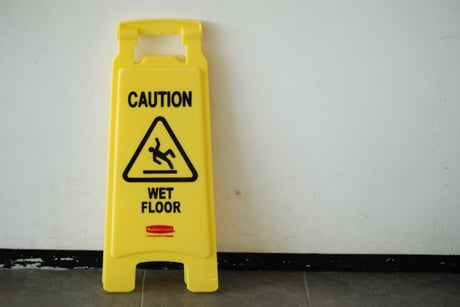Why Disposable Shoe Covers are Not the Best Option for Food Safety
PPE Shoe Covers or disposable booties are a common sight in many food processing facilities. These disposable bags have elastic to help them fit around most types of boots or street shoes and are required to enter production zones to avoid contamination and other food safety risks. They are especially popular among dry production facilities that need a low moisture footwear sanitation solution.
However, while disposable boot covers may be an easy solution to footwear hygiene, they are not without their setbacks. PPE shoe covers don’t remove harmful pathogens, pose a serious risk to employee safety, and can have detrimental impacts to the environment.
PPE Shoe Covers are Inadequate for Pathogen Removal

The soles of our daily footwear are a common place that harmful pathogens can thrive due to our day-to-day mobility. According to a University of Arizona study, coliform and E. coli bacteria were found in 96% of the outside of footwear studied. The study also showed that bacteria can be tracked over a long distance by footwear. Even if an employee of a food processing facility were to thoroughly clean their shoes before the workday, they will inevitably be walking on various sidewalks and parking lots to get to their workplace where others may not have been so attentive to their footwear hygiene. Since disposable boot covers only conceal harmful pathogens rather than remove them, donning PPE shoe covers over any footwear that has been worn outside of a food processing facility can pose a serious food safety risk.
PPE Shoe Covers are a Cross-Contamination Risk
Unfortunately, tracking harmful pathogens to areas where PPE shoe covers are being donned is not a far-fetched occurrence. Unless footwear is sanitized in a separate area from where shoe covers are donned, it is easy for cross-contamination to occur and employees to unintentionally track pathogens to production zones if food safety managers are not being attentive of their hygiene zones. It is therefore necessary for strict monitoring in hygiene zones to ensure that shoes are properly cleaned before donning PPE shoe covers.
It also matters when one puts on a shoe cover, either before or after washing hands. If a person puts on a shoe cover after properly washing their hands they can undo their entire hand washing procedure by touching their shoes which can have harmful pathogens on them. It is therefore necessary for strict monitoring in hygiene zones to ensure that shoes are properly cleaned before donning PPE shoe covers and that hand washing occurs after shoe covers have been donned.
What are the pros and cons of different footwear hygiene methods? Find out here
Disposable Boot Covers Pose a Serious Safety Hazard to Employees
Another often overlooked safety hazard for PPE disposable shoe covers is the process of donning and doffing. Many employees equip their shoe covers by standing on one leg and trying to balance against the wall or anything that can hold their weight. The same goes for the process of removing the covers thus making these processes turn into one-legged balancing acts. It is therefore necessary for hygiene zones to have an adequate number of seats available for employees to properly equip themselves.

Since the purpose of a disposable shoe cover is to separate contact from the shoe and the floor, it also covers any sort of tread on the footwear. If an employee were to accidentally step on a slippery area of the floor, there would be little to no help from their footwear to prevent them from falling and potentially injuring themselves. Plant managers must therefore ensure that any spills or water leaks are promptly attended to in order to ensure their team’s safety.
The Environmental Impact of PPE Shoe Covers
Although the convenience of disposable shoe covers for footwear hygiene is clearly apparent, it does come at a larger price. A food processing facility can go through hundreds of PPE shoe covers during a shift and these covers all eventually end up in the garbage. This contributes a significant amount of waste to landfills, which can take decades to break down and decompose.
Food processing manufacturers have a corporate social responsibility to not only keep their consumers safe but also reduce detrimental impacts their facility operations have on the environment. Any company that tries to reduce their environmental impact, but still utilizes PPE shoe covers is simply not going to meet their sustainability goals.
Learn how Automated Hygiene helps companies meet sustainability goals here
Replacing Disposable Shoe Cover Dispensers for Sustainable Food Safety
Fortunately, there’s an alternative to disposable shoe covers that not only reduces landfill waste but also helps reduce water waste as well. Meritech automated hygiene stations with footwear sanitation enhancements are used by many food safety leaders across the country. These fully automated stations are easy-to-install and can easily fit into hygiene zones at food processing plants, preventing cross-contamination and not being to the environment either. .png?width=355&height=355&name=EVO%20Three%20Sole%20Clean%20Facing%20Front%20(no%20background).png)
CleanTech® Automated Handwashing Stations with the Sole Clean Low Moisture footwear sanitizing pans remove more than 99.9% of harmful pathogens from shoes and doesn’t require any disposable coverings for boots or shoes.
- Guarantees 12 seconds of contact time with footwear during the automated hand wash
- Uses a fast-evaporating alcohol-based solution
- Is compatible with our 2000S and 4000S models
- Works with any type of footwear
- Automatically maintains consistent & necessary PPM
Learn more about Replacing Shoe Cover Dispensers with CleanTech® Here






